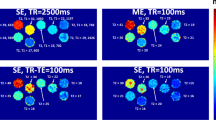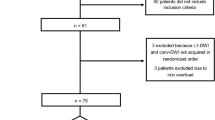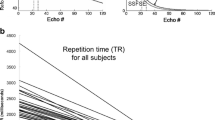Abstract
A new double-echo half-Fourier single-shot turbo spin echo technique has been implemented in which two images are obtained per excitation pulse, one with an echo time (TE) of 60 ms and another with a TE of 438 ms. The acquisition window per image is 380 ms and is determined by the echo spacing of 4.3 ms and the echo train length of 88 for images with resolution of 160×256. No breath holding was performed. The aim of the study was to test whether the additional information of the late TE image improves the characterization of liver lesions. Twenty-eight patients with 39 focal liver lesions (9 cysts, 11 hemangiomas, and 19 solid lesions) were imaged with the new technique, and signal intensity (SI) ratios of lesion and liver were obtained. At-test analysis showed that in the TE 60 ms image, SI ratios of cysts and hemangiomas were not significantly different, whereas in the TE 438 ms images the two types of lesions can be classified. Signal intensity ratios of solid lesions were in both images clearly lower than those of cysts and hemangiomas. The technique, therefore, seems a promising and straightforward new tool for the characterization of liver lesions.
Similar content being viewed by others
References
Glazer G, Aisen A, Francis I, Gves J, Lande I, Adler D (1985) Hepatic cavernous hemangioma: magnetic resonance imaging.Radiology 155: 417–420.
Ohtomi K, Itai Y, Furiri S, Yashiro N, Yoshikawa K, Iio M (1985) Hepatic tumors: differentiation by transverse relaxation time (T2) of magnetic resonance imaging.Radiology 155: 421–423.
Stark DD, Felder RC, Wittenberg J, et al. (1985) Magnetic resonance imaging of cavernous hemangioma of the liver: tissue specific characterization.AJR Am J Roentgenol 145: 213–222
Wittenberg J, Stark DD, Forman BH, et al. (1988) Differentiation of hepatic metastases from hepatic hemangiomas and cysts using MR imaging.AJR Am J Roentgenol 151: 79–84.
Egglin K, Rummeny E, Stark DD, Wittenberg J, Saini S, Ferrucci JT (1990) Hepatic tumors: quantitative tissue characterization with MR imaging.Radiology 176: 107–110.
Foley WD, Kneeland JB, Cates JD (1987) Contrast optimization for the detection of focal hepatic lesions by MR imaging.AJR Am J Roentgenol 149: 1155–1160.
McFarland E, Mayo-Smith W, Saini S, Hahn P, Goldberg M, Lee M (1994) Hepatic hemangiomas and malignant tumors: improved differentiation with heavily T2 weighted conventional spin echo MR imaging.Radiology 193: 43–47.
Hennig J, Nauerth A, Friedburg H (1986) RARE, imaging: a fast imaging method for clinical MR.Magn Reson Med 3: 823–833.
Mitchell DG (1996) Fast MR imaging techniques: impact in the abdomen.JMRI 6: 812–821.
Riederer SJ (1996) Recent technical advances in MR imaging of the abdomen.JMRI 6: 822–832.
Rydberg JN, Lomas DJ, Coakley KJ, Hough DM, Ehman RL, Riederer SJ (1995) Comparison of breath-hold fast spin echo conventional spin-echo pulse sequences for T2 weighted MR imaging of liver, lesions.Radiology 194: 431–437.
Kiefer B, Grässner J, Hausmann R (1994) Image acquisition in a second with half-Fourier acquisition single shot turbo, spin echo.J Magn Reson 4(Suppl P): 86–87.
Gaa J, Hatabu H, Jenkins RL, Finn JP, Edelman RR (1996) Liver masses: replacement of conventional T2 weighted spin echo MR imaging with breath-hold MR imaging.Radiology 200: 459–464.
Van Hoe L, Bosmans H, Aerts P, Baert AL, Kiefer B, Fevery L, Marchal G (1996) Ultrafast single-shot T2 weighted MR imaging of the liver: evaluation of a half-Fourier RARE sequence.Radiology (in press).
Vogl TJ, Hammerstingl R, Schwarz W, Mack M, Müller PK, Pegios W, Keck H, Eibl-Eibesfeldt A, Hoelzl J, Woessmer B, Bergman C, Felix R (1996) Superparamagnetic iron oxide-enhanced versus gadolinium-enhanced MR imaging for differential diagnosis of focal liver lesions.Radiology 198: 881–887.
Goldberg MA, Hahn PF, Saini S (1993) Value of T1 and T2 relaxation times from echo planar MR imaging in the characterization of focal hepatic lesions.AJR Am J Roentgenol 160: 1011–1017.
Author information
Authors and Affiliations
Rights and permissions
About this article
Cite this article
Bosmans, H., Gryspeerdt, S., Van Hoe, L. et al. Preliminary experience with a new double-echo half-Fourier single-shot turbo spin echo acquisition in the characterization of liver lesions. MAGMA 5, 79–84 (1997). https://doi.org/10.1007/BF02592270
Received:
Accepted:
Issue Date:
DOI: https://doi.org/10.1007/BF02592270




